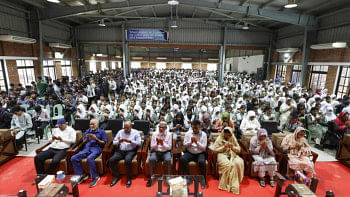Heritage weaves

Historical accounts are flooded with anecdotes of how cotton goods of Bengal attracted the attention of the whole world. As early as the fourteenth century, when Sultan Ghiyasuddin Azam Shah (1389-1410) invited the Persian poet, Hafiz of Shiraz, to his court, he had sent Muslins as imperial gifts.
Fast forward to the Mughal era, was a favourite of Emperor Aurangzeb. On the other hand, in his book 'A Sketch of the Topography & Statistics of Dacca,' published in 1840, surgeon James Taylor said that muslins 'were known in Europe in the first century of the Christian era' and that 'they were highly prized by the ladies of Imperial Rome…”
Jamdani is a surviving variety of muslin, and the traditional art of weaving has been enshrined in UNESCO's Representative List of the Intangible Cultural Heritage of Humanity. The age-old process of making has largely remained unchanged.

It takes two people to produce a sari: a master weaver and an apprentice. The handloom, interestingly enough, is noiseless. Weaving is a intricate procedure, and requires utmost concentration. Craftsmen work anywhere between about a week and a few months to complete one sari, and the patterns reflect the flora and fauna of our country, from flowers to creepers to small fish.
Tangail saris too are in a league of their own. The looms of the region has seen revival and is gradually growing in popularity. They are indeed a fashionable and comfortable wear. And there is something about hand woven fabric that modern mass-scale equipment cannot replace.
Another pride of our country is the Nakshi Kantha. 'Nakshi' basically refers to designs or motifs. And 'kantha' is quilt. Nakshi Kantha essentially means quilts with designs and motifs. It is, by all means, functional art. And the designs tell stories of lives and sorrows and surroundings of their makers. Quilt is, by every right, a form of canvas, a medium for artistic expression.
Meanwhile, Comilla is well reputed for its khadi, and it has a long history. Marco Polo had commented on the fineness of the khadi of Bengal, saying that it is finer than a spider's web. A hand-spun and hand-woven fabric, the khadi is also very popular in India. Mohandas Karamchand Gandhi was a heavy promoter of the fabric, using it as a component to make India self-reliant.
Indeed, we as Bangladeshis have a lot to be proud of when it comes to heritage weaves. And since we have inherited them all, it is our duty to protect them and ensure that the weaving sustains in our generation and those that will come in the future.
Fortunately, many individuals and organisations have come forward to help the weavers and revive the industry. The recent times have seen several exhibitions and many other attempts for raising awareness about their value. But each of us must do our bit. And one of the best ways to do that is to be a customer.
Many weavers have left their work to join other professions, leaving the trade of their forefathers in pursuit of better pay. As customers, we can provide an enormous support to this industry.
When you buy a sari, you are essentially paying for a weaver's one week's (or more) work. Therefore, it is vital that the fabrics or weaves have enough sales for them to be a lucrative and sustainable trade.

During Eid, most people spend hefty amounts in shopping. Many opt for imported clothes rather than going for the 'deshi' ones. This trend needs to change for the better. The more we purchase the traditional products of our country, the better is the chance for them to survive and flourish.
Naksi Kantha is a work of art. A piece of Nakshi Kantha is unique from the rest – it is the distinctive artistic expression of the creator that adds a lot of intrinsic value. Therefore, when you are buying this quilt, you are essentially buying a work of art.
Prices of many of the attires are affordable. You can purchase a sari by spending just a few thousand takas, or even less. Indeed, there are premium ones in the market too, and prices can go as high as Tk100,000 or more. Even if you cannot spend a hefty sum, there are cheaper options too.
From gifts to bridal wear to regular wear, customers can take these creative industries a long way.
And, in the process, we can save an integral part of our heritage. There are things we have already lost, like the different varieties of Muslins. But we still have a lot of fabrics that capture worldwide attention. If we fail to give these industries proper attention, support and patronage, then these heritages will eventually be lost forever.
Let's not let that happen.
The writer is a reporter and feature writer for Lifestyle, The Daily Star.
Photo: Sazzad Ibne Sayed
Model: Amily
Wardrobe: Aarong
Location: A Restoran
Make-up: Farzana Shakil

 For all latest news, follow The Daily Star's Google News channel.
For all latest news, follow The Daily Star's Google News channel. 



Comments